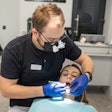
About 75% of racial and ethnic minorities and patients with low socioeconomic status reported that dental professionals did not screen them for oral cancer during dental visits, according to a new study.
The lag in oral cancer screening rates is occurring despite the fact that lower-income groups are more likely to be diagnosed with advanced-stage oral cancer, the study authors noted in the American Journal of Preventive Medicine (August 20, 2019). Selective screening also fails to comply with ADA guidelines.
The researchers used data from the National Health and Nutrition Examination Survey (NHANES) from 2011 and 2016. They analyzed data for individuals age 30 and older who had seen a dentist in the previous two years.
The sample size for intraoral cancer screenings was approximately 9,300 individuals, and the size for extraoral screenings was about 6,260. Nearly 38% reported receiving intraoral oral cancer screenings, and approximately 31% reported receiving extraoral cancer exams.
The researchers found that the following groups were less likely to be screened for oral cancer:
- Nonwhites
- Patients with lower incomes
- Individuals with less education
- Uninsured patients or those covered by Medicaid
Care delivery inequalities
Since these patients had visited dentists, the findings highlight the inequalities in the delivery of care independent of access to care, according to the researchers.
The most unfortunate finding of the study was that it shows how socioeconomically disadvantaged populations were less likely to be screened, even with high-risk behaviors, such as smoking or consuming alcohol, lead author Avni Gupta, BDS, MPH, told DrBicuspid.com. Gupta is a research scientist and senior project manager at the Center for Surgery and Public Health at Brigham and Women's Hospital in Boston.
"These behaviors are part of the patient history profile, and still in our study we found that dental patients with these high-risk behaviors are not receiving recommended oral cancer screening services if they were from minority racial/ethnic groups, low income, less educated, and publicly insured or uninsured," Gupta wrote.
These disparities may exist for multiple reasons.
Some dental professionals might not screen these groups due to system-level factors, such as a higher incidence of dental disease, Gupta noted. For example, dental professionals who serve low-income patients might spend so much time treating severe dental problems that they don't have time to perform an oral cancer screening exam.
"They might be running a busy clinic because they take these patients and, hence, leaving no time for nonsymptomatic issues to be addressed," she wrote.
Also, differences in screening rates may be the result of patient-level factors, such as patients not knowing they should ask for screenings or not trusting dental professionals after hearing exam explanations, according to Gupta.
Provider-level factors also can play a role. Dental professionals may not have the communication skills needed to explain cancer screenings to those from diverse backgrounds, or these practitioners may have personal biases.
They may assume that patients with these characteristics will not understand the importance of the screening exam, Gupta stated.
A missed opportunity
Though the findings can help the oral health community develop effective interventions, the study had some limitations. The primary limitation was the use of self-reported data, which makes it subject to recall bias. However, this would only affect the study results if these biases had greater influence on some sociodemographic groups than others.
Gupta explained that not screening these patients was a missed opportunity for early detection and better oral cancer outcomes. Now that dental professionals are aware of the disparities, they need to evaluate whether the discrimination is conscious or unconscious.
"Are [these patients] facing barriers of their own or there are system-level or patient-level deterrents? Actions will depend on the barriers, which might be different for different professionals and areas or settings. The goal should be ... to provide all recommended services with the highest quality to all patients," Gupta wrote.




















